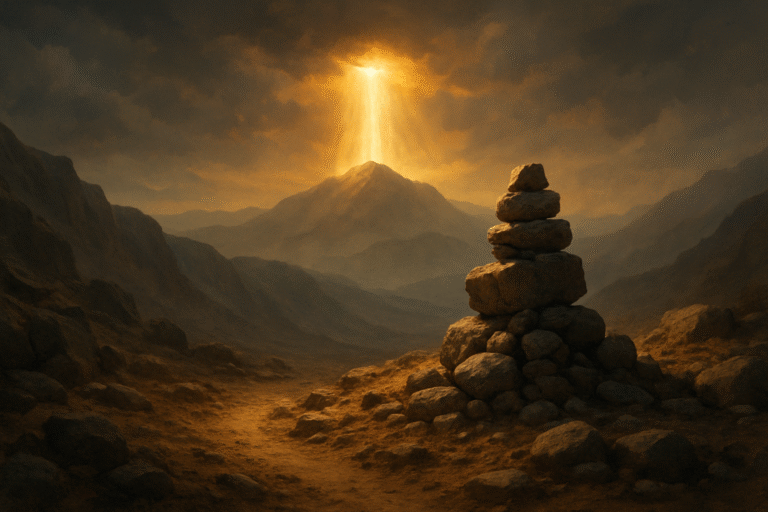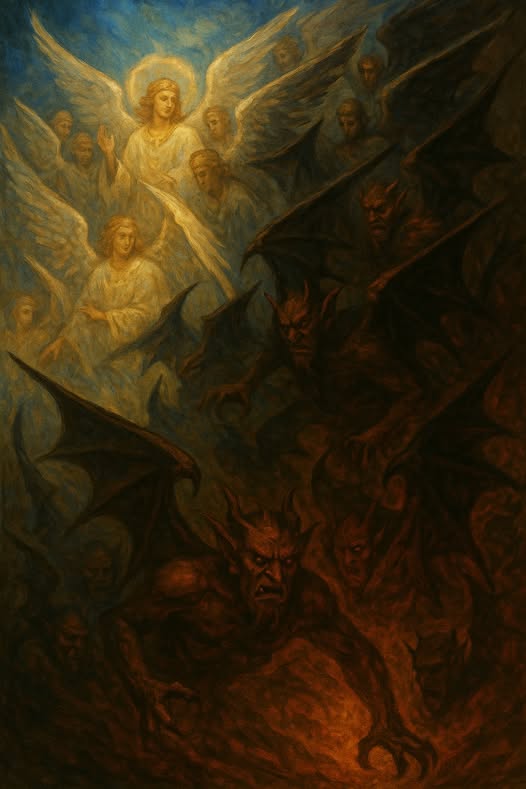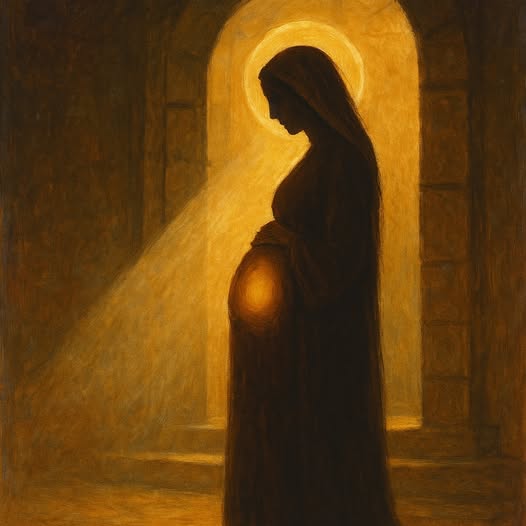
In the religious landscape of the ancient Near East, the gods of the nations built elaborate systems of authority designed to control people, reflect cosmic order, and justify their worship. Among these figures were El, the aged high god of the Canaanite pantheon, and Baal, the active storm god and fertility deity. Some scholars have claimed that Israel’s God, Yahweh, began as a regional or subordinate deity, a “son of El”—who later rose to preeminence.
However, the biblical record tells a different story. Yahweh was never subordinate. He is the Most High from the beginning, and the gods of the nations—those who had rebelled—deliberately constructed theological systems to suppress His identity, diminish His authority, and insert others like Baal in His place.
El in the Canaanite Pantheon
In the Ugaritic texts from Ras Shamra, El is portrayed as the distant father of the gods. He lives at the source of the cosmic waters, holds the title of “Bull El the Compassionate,” and sits at the head of the divine council. However, El is largely passive. The real narrative energy is driven by his offspring, especially Baal, who rises to prominence as the king of the gods, defeating sea monsters, bringing rain, and constructing his own palace.
This council of gods—bn il, the “sons of El”—becomes a key concept. Scholars drawing on these myths have tried to place Yahweh in this structure, as if He were simply one of the sons under El’s rule.
The Scholarly Claim: Yahweh as a Son of El
A number of modern scholars, working from comparative religion and archaeological parallels, have proposed that Yahweh began as one of the “sons of El,” possibly a southern warrior god from Edom or Midian, who was later absorbed into the religion of Israel. According to this theory:
- Yahweh originally existed within a Canaanite-style pantheon.
- He was considered a subordinate deity under El.
- Over time, Israelite religion merged Yahweh with El, elevating Him to the role of the supreme God.
This theory relies on structural parallels with Ugaritic myth and references to Yahweh’s early geographic associations, such as Seir, Teman, or Edom, as well as Egyptian texts referencing “Yhw in the land of the Shasu.” However, the biblical narrative and worldview directly refute this construction.
The Biblical Response: Yahweh Is the Most High
The Bible does not describe Yahweh as rising from the ranks of other gods. It presents Him from the beginning as unique, sovereign, and above all. Two key passages explicitly dismantle the “son of El” theory.
Deuteronomy 32:8–9, in the Septuagint and Dead Sea Scrolls versions, says that when the Most High divided the nations, He gave them to the “sons of God,” but retained Israel for Himself. Yahweh is not one of the recipients. He is the one doing the assigning. This text identifies Yahweh with the Most High, not with the subordinate divine beings.
Psalm 82 presents Yahweh standing in judgment over the divine council, accusing the “gods” of injustice and sentencing them to death. He is not their peer. He is their Judge. This reverses the divine hierarchy assumed in Canaanite myth.
Far from being a son of El, Yahweh is the Most High. The “son of El” slot in Canaanite theology belongs to Baal, who became the central figure of counterfeit religion in the region. The biblical writers do not adopt this structure. They reject and overturn it.
Baal as the Mask of Satan
Baal was the dominant god in the Canaanite religious system, known as the storm deity, the fertility provider, and the so-called “cloud rider.” Ugaritic myths describe him defeating Yam, building his palace on a divine mountain, and claiming authority over nature and kingship. His cult promoted ritual sex, divination, political manipulation, and in many contexts, child sacrifice. These actions were not merely cultural practices. They were the expression of spiritual rebellion against the Most High. Baal was not simply a false god—he was a manifestation of Satan himself, operating under a regional name to deceive the nations.
Throughout Scripture, Yahweh confronts Baal not as a rival peer, but as a pretender who stole imagery and titles that never belonged to him. Psalm 29 declares that the storm is Yahweh’s domain. Isaiah 27:1 and Psalm 74:13–14 show that Yahweh, not Baal, slays Leviathan. Psalm 68:4 and Isaiah 19:1 present Yahweh—not Baal—as the true one who rides on the clouds. These declarations are not poetic flourishes—they are theological corrections aimed directly at the claims made by Baal, who, under the mask of Satan, positioned himself to be worshiped as god over the nations.
The New Testament reveals the same pattern. In Luke 4:5–7, Satan offers Jesus the kingdoms of the world in exchange for worship. This mirrors Baal’s role in demanding worship in return for provision, fertility, and political power. Paul calls Satan the “god of this age” in 2 Corinthians 4:4, showing that the same deceiver behind Baal’s cult continues to blind the nations. Revelation 12–13 makes clear that Satan, portrayed as the dragon, empowers the beast to deceive the whole world, demand worship, and war against the saints—just as Baal once stood opposed to Yahweh’s prophets and people.
From the rebellion at Babel described in Deuteronomy 32 to the judgment in Psalm 82, the Bible shows that the gods of the nations were real spiritual beings who abandoned their divine assignments and led humanity into darkness. Among them, the one behind Baal was not merely a participant—he was the architect. Baal is Satan operating in disguise, presenting himself as king, provider, storm god, and lord of nations, all to draw worship away from Yahweh and toward himself.
Yahweh does not respond by reclaiming anything from Baal. Nothing was ever Baal’s to begin with. Instead, Yahweh exposes Baal’s lies, condemns his rebellion, and reveals what was true all along—that He alone is Most High over all the earth. In Christ, this satanic masquerade is fully unmasked. The throne Baal claimed is shattered, and the One who truly rides the clouds returns to reign.
Israel’s Theology as a Polemic
Far from being influenced by Canaanite theology, Israel’s Scriptures are constructed as a direct polemic against it. The prophets do not negotiate with Baal worship. They declare it abominable. Elijah’s confrontation on Mount Carmel (1 Kings 18) reveals that Baal has no power in the face of Yahweh. He cannot send fire or rain. Yahweh alone answers.
Biblical theology reclaims sacred space, sacred imagery, and sacred authority. The mountain, the storm, the cloud, and the sea all belong to Yahweh. These elements appear in other systems because the rebel gods took fragments of truth and distorted them. Scripture does not reflect myth. It reclaims reality.
The Final Revelation in Christ
Christ is the ultimate expression of Yahweh’s identity and authority. In Mark 14:62, Jesus identifies Himself as the Son of Man who will come on the clouds of heaven, echoing Daniel 7:13 and reclaiming the title falsely worn by Baal. In Revelation 19, Christ returns as the righteous King, crowned and bearing the Name of God.
The divine imposters who tried to bury Yahweh beneath layers of myth and rebellion will fall. The One who was slandered, diminished, and rejected by the gods of the nations will reign in full view. Yahweh was never subordinate. He was never a myth. He is the Creator, the Judge, and the Redeemer.
What Secular Scholarship Misses: The Gods Were Real, and They Rebelled
Modern scholarship, while frequently instructive and useful, typically treats ancient deities as fictional products of early imagination or sociopolitical control. In this view, El, Baal, and Yahweh are literary constructs that evolved as cultures changed. But the biblical worldview presents a different reality. The gods of the nations were not imaginary. They were real spiritual beings, originally appointed to oversee the nations after Babel (Deuteronomy 32:8–9), who later rebelled against Yahweh.
Psalm 82 reveals that these beings ruled unjustly, leading humanity into darkness and idolatry. Their rebellion was not passive. It was active theological warfare. By inserting themselves into the worship of nations and crafting systems in which Yahweh appeared absent, minor, or subordinate, these gods disguised the truth. Baal became the “cloud rider.” El became a distant high god. Yahweh was either forgotten or transformed into a lesser figure.
this
This was not cultural development. It was propaganda engineered by spiritual rebels. And secular scholarship, by refusing to acknowledge the existence of these beings, fails to understand why the ancient systems look the way they do. The false myths were not random. They were built to suppress the name of the Most High and to deceive the nations into turning away from Him.
Conclusion
The ancient gods of the nations sought to suppress the identity of Yahweh by casting Him as a minor deity, a son of El, or a local god. Modern scholarship has often repeated this error by treating these theological propaganda systems as the source of Israelite religion. But the Bible says otherwise. Yahweh is not a product of religious evolution. He is El Elyon, the Most High, who judges the gods, reclaims the nations, and rules forever. The gods of the nations tried to bury Him. But He will be exalted among them all.
Discussion Questions
- Why does the biblical text portray Yahweh as judging the gods of the nations rather than being one among them?
- How does the belief that the gods of the nations are real spiritual beings shape our understanding of their myths and religious systems?
- In what ways does Baal function as a counterfeit of Yahweh in ancient Near Eastern religion?
- What evidence from Scripture directly refutes the claim that Yahweh was originally a son of El?
- Why is it significant that Jesus identifies Himself with titles and imagery once falsely claimed by Baal and other rebel gods?
Want to Know More?
- Michael S. Heiser – The Unseen Realm: Recovering the Supernatural Worldview of the Bible
Heiser’s landmark work provides the most comprehensive treatment of the divine council worldview, showing that biblical theology assumes the real existence of lesser divine beings. He argues that passages like Deuteronomy 32 and Psalm 82 describe actual spiritual rebellion and that Yahweh’s authority is unique among these beings. Essential for understanding how Israel’s God was not one of many, but the one who rules over all. - Derek P. Gilbert – The Second Coming of Saturn: The Great Conjunction, America’s Temple, and the Return of the Watchers
Gilbert connects the gods of ancient myth, such as El and Baal, with demonic entities still at work in modern religious and political systems. He argues that Baal and similar figures function as avatars of Satan, especially in the context of eschatology. This book is helpful for seeing how ancient theological propaganda still echoes in modern rebellion. - John D. Currid – Against the Gods: The Polemical Theology of the Old Testament
Currid argues that the Old Testament writers were not borrowing from Canaanite religion but actively refuting it. He shows how the biblical text reclaims storm imagery, creation themes, and divine titles in order to assert Yahweh’s supremacy. A key source for understanding how the Bible confronts and corrects false religious systems. - Brian Godawa – The Myth That Is True (Essay Series)
Godawa blends biblical theology with mythological insight to show how pagan systems are distortions of biblical truth. He explores the way symbols like dragons, mountains, and the abyss are misused by false gods, and how Christ reclaims them. These essays are excellent for readers wanting accessible theological reflection tied to cosmic themes. - Daniel Block – The Gods of the Nations: Studies in Ancient Near Eastern National Theology
Block examines how ancient nations understood their gods and how those beliefs differed from biblical theology. He shows that Yahweh’s relationship with Israel was utterly unique and based on covenant, not territorial control or patronage. This resource strengthens the claim that Yahweh was not a local deity elevated by myth but always stood apart. - Stephen Dempster – Dominion and Dynasty: A Biblical Theology of the Hebrew Bible
Dempster traces the narrative arc of Scripture, emphasizing the themes of divine rule and covenant loyalty. He shows how Yahweh’s kingship unfolds against the backdrop of rebellion, idolatry, and exile. While not focused on Canaanite myth, this work helps place the divine conflict in the broader storyline of Scripture. - T. Desmond Alexander – From Eden to the New Jerusalem: An Introduction to Biblical Theology
This book explores how the Bible’s theological themes—especially those related to sacred space, God’s presence, and divine rule—develop from Genesis to Revelation. Alexander shows how false religious systems mimic but fail to deliver what only Yahweh can. Useful for readers who want to understand the overarching contrast between the kingdom of God and the kingdoms of the world. - Douglas Van Dorn – The Unseen Realm Companion: A Study Guide to the Supernatural Worldview of the Bible
This is a guided companion to Heiser’s work, great for study groups or those looking to go deeper. It helps readers grasp the reality of the divine council and the ongoing war between Yahweh and the rebellious sons of God. Includes questions and reflections that tie into practical theology. - Peter Gentry and Stephen Wellum – Kingdom through Covenant: A Biblical-Theological Understanding of the Covenants
This book explains how the covenants in Scripture reveal Yahweh’s unique identity and intentions for His people. It provides a powerful contrast with how the gods of the nations demanded loyalty through manipulation and fear, whereas Yahweh operates through loving covenantal relationship. - E. Theodore Mullen – The Assembly of the Gods: The Divine Council in Canaanite and Early Hebrew Literature
Though written from an academic perspective, this book gives important historical insight into how the divine council was viewed across the ancient Near East and in early Israelite religion. Mullen does not share Heiser’s theological conclusions but helps document the comparative material. Good for understanding how scholars construct the “Yahweh as son of El” argument and why it ultimately fails when compared with Scripture.






